Umberto Michieli
MOCHA: Multi-modal Objects-aware Cross-arcHitecture Alignment
Sep 17, 2025Abstract:We introduce MOCHA (Multi-modal Objects-aware Cross-arcHitecture Alignment), a knowledge distillation approach that transfers region-level multimodal semantics from a large vision-language teacher (e.g., LLaVa) into a lightweight vision-only object detector student (e.g., YOLO). A translation module maps student features into a joint space, where the training of the student and translator is guided by a dual-objective loss that enforces both local alignment and global relational consistency. Unlike prior approaches focused on dense or global alignment, MOCHA operates at the object level, enabling efficient transfer of semantics without modifying the teacher or requiring textual input at inference. We validate our method across four personalized detection benchmarks under few-shot regimes. Results show consistent gains over baselines, with a +10.1 average score improvement. Despite its compact architecture, MOCHA reaches performance on par with larger multimodal models, proving its suitability for real-world deployment.
HydraOpt: Navigating the Efficiency-Performance Trade-off of Adapter Merging
Jul 23, 2025Abstract:Large language models (LLMs) often leverage adapters, such as low-rank-based adapters, to achieve strong performance on downstream tasks. However, storing a separate adapter for each task significantly increases memory requirements, posing a challenge for resource-constrained environments such as mobile devices. Although model merging techniques can reduce storage costs, they typically result in substantial performance degradation. In this work, we introduce HydraOpt, a new model merging technique that capitalizes on the inherent similarities between the matrices of low-rank adapters. Unlike existing methods that produce a fixed trade-off between storage size and performance, HydraOpt allows us to navigate this spectrum of efficiency and performance. Our experiments show that HydraOpt significantly reduces storage size (48% reduction) compared to storing all adapters, while achieving competitive performance (0.2-1.8% drop). Furthermore, it outperforms existing merging techniques in terms of performance at the same or slightly worse storage efficiency.
Brain-inspired sparse training enables Transformers and LLMs to perform as fully connected
Jan 31, 2025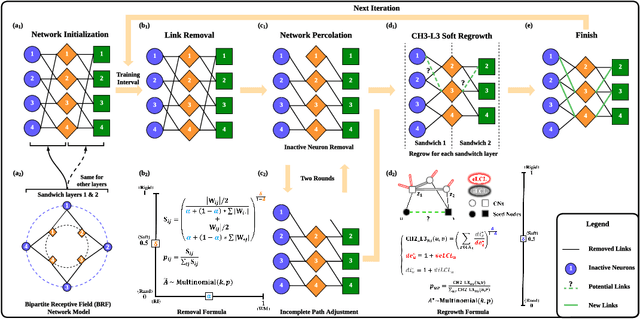
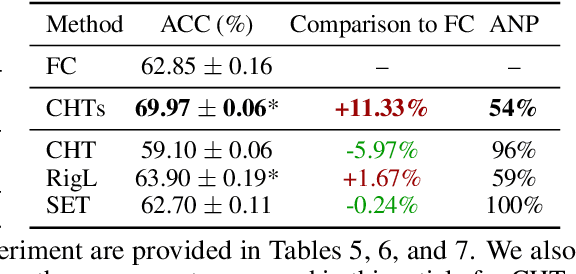
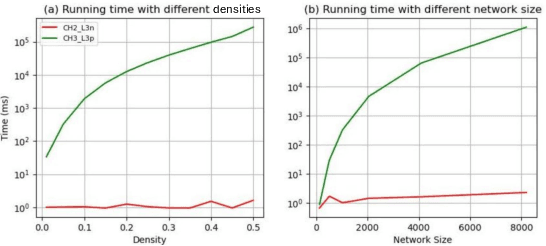
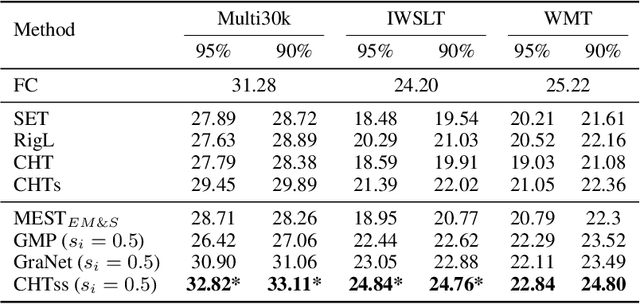
Abstract:This study aims to enlarge our current knowledge on application of brain-inspired network science principles for training artificial neural networks (ANNs) with sparse connectivity. Dynamic sparse training (DST) can reduce the computational demands in ANNs, but faces difficulties to keep peak performance at high sparsity levels. The Cannistraci-Hebb training (CHT) is a brain-inspired method for growing connectivity in DST. CHT leverages a gradient-free, topology-driven link regrowth, which has shown ultra-sparse (1% connectivity or lower) advantage across various tasks compared to fully connected networks. Yet, CHT suffers two main drawbacks: (i) its time complexity is O(Nd^3) - N node network size, d node degree - hence it can apply only to ultra-sparse networks. (ii) it selects top link prediction scores, which is inappropriate for the early training epochs, when the network presents unreliable connections. We propose a GPU-friendly approximation of the CH link predictor, which reduces the computational complexity to O(N^3), enabling a fast implementation of CHT in large-scale models. We introduce the Cannistraci-Hebb training soft rule (CHTs), which adopts a strategy for sampling connections in both link removal and regrowth, balancing the exploration and exploitation of network topology. To improve performance, we integrate CHTs with a sigmoid gradual density decay (CHTss). Empirical results show that, using 1% of connections, CHTs outperforms fully connected networks in MLP on visual classification tasks, compressing some networks to < 30% nodes. Using 5% of the connections, CHTss outperforms fully connected networks in two Transformer-based machine translation tasks. Using 30% of the connections, CHTss achieves superior performance compared to other dynamic sparse training methods in language modeling, and it surpasses the fully connected counterpart in zero-shot evaluations.
Controllable Forgetting Mechanism for Few-Shot Class-Incremental Learning
Jan 27, 2025Abstract:Class-incremental learning in the context of limited personal labeled samples (few-shot) is critical for numerous real-world applications, such as smart home devices. A key challenge in these scenarios is balancing the trade-off between adapting to new, personalized classes and maintaining the performance of the model on the original, base classes. Fine-tuning the model on novel classes often leads to the phenomenon of catastrophic forgetting, where the accuracy of base classes declines unpredictably and significantly. In this paper, we propose a simple yet effective mechanism to address this challenge by controlling the trade-off between novel and base class accuracy. We specifically target the ultra-low-shot scenario, where only a single example is available per novel class. Our approach introduces a Novel Class Detection (NCD) rule, which adjusts the degree of forgetting a priori while simultaneously enhancing performance on novel classes. We demonstrate the versatility of our solution by applying it to state-of-the-art Few-Shot Class-Incremental Learning (FSCIL) methods, showing consistent improvements across different settings. To better quantify the trade-off between novel and base class performance, we introduce new metrics: NCR@2FOR and NCR@5FOR. Our approach achieves up to a 30% improvement in novel class accuracy on the CIFAR100 dataset (1-shot, 1 novel class) while maintaining a controlled base class forgetting rate of 2%.
LoRA.rar: Learning to Merge LoRAs via Hypernetworks for Subject-Style Conditioned Image Generation
Dec 06, 2024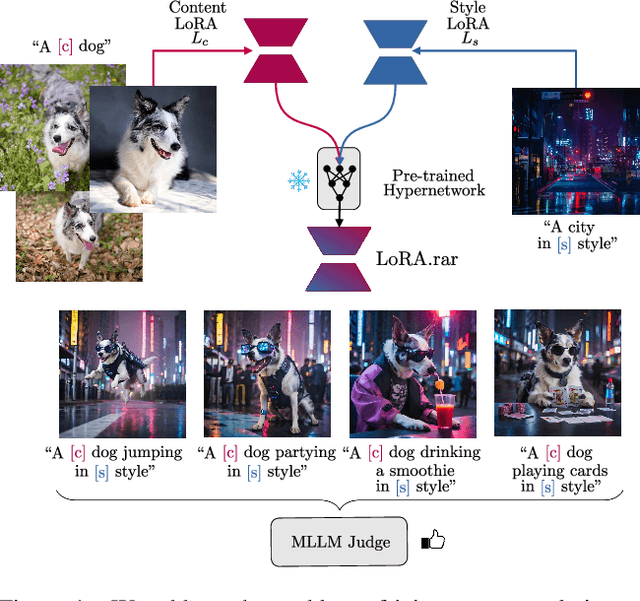
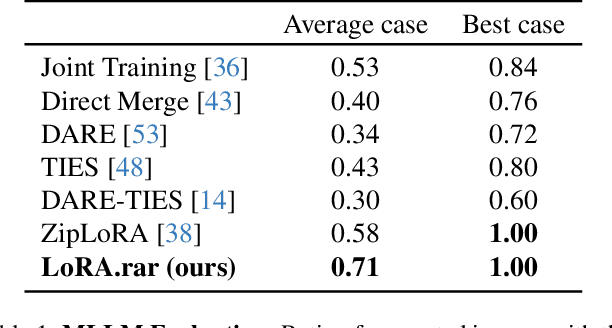
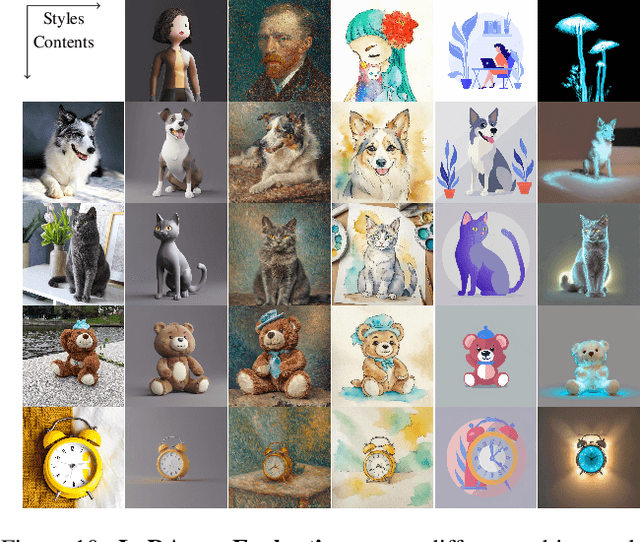
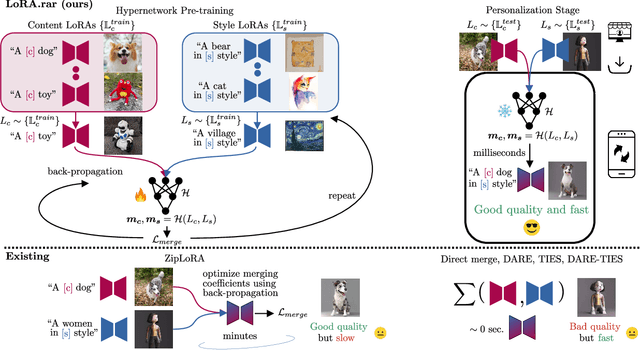
Abstract:Recent advancements in image generation models have enabled personalized image creation with both user-defined subjects (content) and styles. Prior works achieved personalization by merging corresponding low-rank adaptation parameters (LoRAs) through optimization-based methods, which are computationally demanding and unsuitable for real-time use on resource-constrained devices like smartphones. To address this, we introduce LoRA$.$rar, a method that not only improves image quality but also achieves a remarkable speedup of over $4000\times$ in the merging process. LoRA$.$rar pre-trains a hypernetwork on a diverse set of content-style LoRA pairs, learning an efficient merging strategy that generalizes to new, unseen content-style pairs, enabling fast, high-quality personalization. Moreover, we identify limitations in existing evaluation metrics for content-style quality and propose a new protocol using multimodal large language models (MLLM) for more accurate assessment. Our method significantly outperforms the current state of the art in both content and style fidelity, as validated by MLLM assessments and human evaluations.
DreamCache: Finetuning-Free Lightweight Personalized Image Generation via Feature Caching
Nov 26, 2024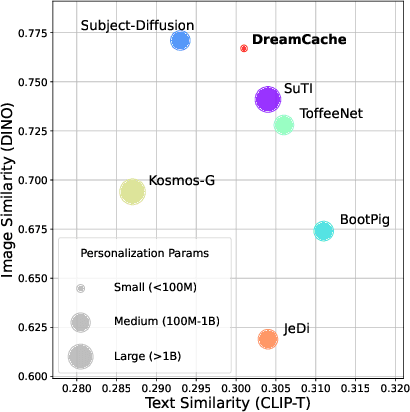
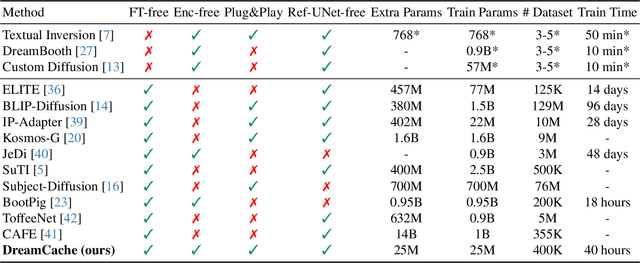
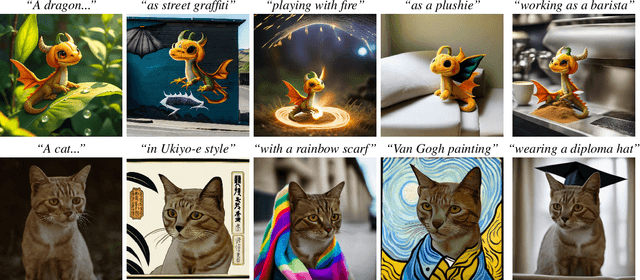
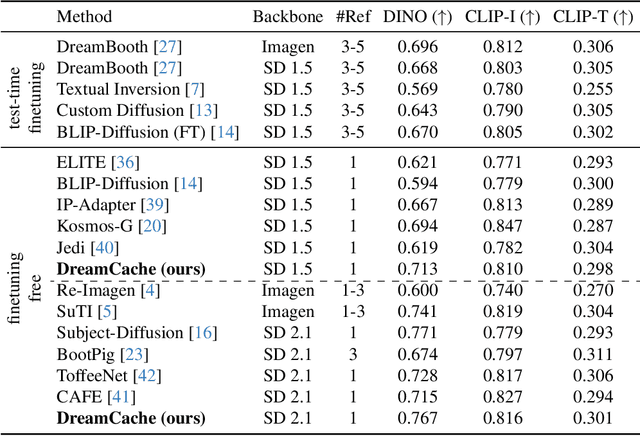
Abstract:Personalized image generation requires text-to-image generative models that capture the core features of a reference subject to allow for controlled generation across different contexts. Existing methods face challenges due to complex training requirements, high inference costs, limited flexibility, or a combination of these issues. In this paper, we introduce DreamCache, a scalable approach for efficient and high-quality personalized image generation. By caching a small number of reference image features from a subset of layers and a single timestep of the pretrained diffusion denoiser, DreamCache enables dynamic modulation of the generated image features through lightweight, trained conditioning adapters. DreamCache achieves state-of-the-art image and text alignment, utilizing an order of magnitude fewer extra parameters, and is both more computationally effective and versatile than existing models.
Randomized Asymmetric Chain of LoRA: The First Meaningful Theoretical Framework for Low-Rank Adaptation
Oct 10, 2024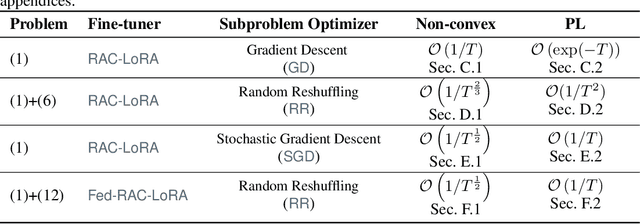
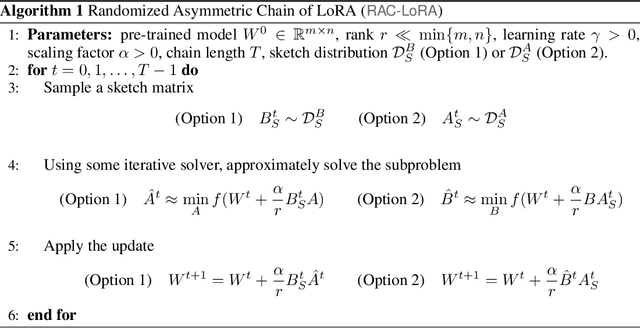
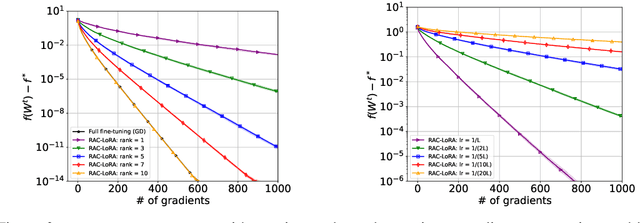

Abstract:Fine-tuning has become a popular approach to adapting large foundational models to specific tasks. As the size of models and datasets grows, parameter-efficient fine-tuning techniques are increasingly important. One of the most widely used methods is Low-Rank Adaptation (LoRA), with adaptation update expressed as the product of two low-rank matrices. While LoRA was shown to possess strong performance in fine-tuning, it often under-performs when compared to full-parameter fine-tuning (FPFT). Although many variants of LoRA have been extensively studied empirically, their theoretical optimization analysis is heavily under-explored. The starting point of our work is a demonstration that LoRA and its two extensions, Asymmetric LoRA and Chain of LoRA, indeed encounter convergence issues. To address these issues, we propose Randomized Asymmetric Chain of LoRA (RAC-LoRA) -- a general optimization framework that rigorously analyzes the convergence rates of LoRA-based methods. Our approach inherits the empirical benefits of LoRA-style heuristics, but introduces several small but important algorithmic modifications which turn it into a provably convergent method. Our framework serves as a bridge between FPFT and low-rank adaptation. We provide provable guarantees of convergence to the same solution as FPFT, along with the rate of convergence. Additionally, we present a convergence analysis for smooth, non-convex loss functions, covering gradient descent, stochastic gradient descent, and federated learning settings. Our theoretical findings are supported by experimental results.
Swiss DINO: Efficient and Versatile Vision Framework for On-device Personal Object Search
Jul 10, 2024Abstract:In this paper, we address a recent trend in robotic home appliances to include vision systems on personal devices, capable of personalizing the appliances on the fly. In particular, we formulate and address an important technical task of personal object search, which involves localization and identification of personal items of interest on images captured by robotic appliances, with each item referenced only by a few annotated images. The task is crucial for robotic home appliances and mobile systems, which need to process personal visual scenes or to operate with particular personal objects (e.g., for grasping or navigation). In practice, personal object search presents two main technical challenges. First, a robot vision system needs to be able to distinguish between many fine-grained classes, in the presence of occlusions and clutter. Second, the strict resource requirements for the on-device system restrict the usage of most state-of-the-art methods for few-shot learning and often prevent on-device adaptation. In this work, we propose Swiss DINO: a simple yet effective framework for one-shot personal object search based on the recent DINOv2 transformer model, which was shown to have strong zero-shot generalization properties. Swiss DINO handles challenging on-device personalized scene understanding requirements and does not require any adaptation training. We show significant improvement (up to 55%) in segmentation and recognition accuracy compared to the common lightweight solutions, and significant footprint reduction of backbone inference time (up to 100x) and GPU consumption (up to 10x) compared to the heavy transformer-based solutions.
Enhanced Model Robustness to Input Corruptions by Per-corruption Adaptation of Normalization Statistics
Jul 08, 2024Abstract:Developing a reliable vision system is a fundamental challenge for robotic technologies (e.g., indoor service robots and outdoor autonomous robots) which can ensure reliable navigation even in challenging environments such as adverse weather conditions (e.g., fog, rain), poor lighting conditions (e.g., over/under exposure), or sensor degradation (e.g., blurring, noise), and can guarantee high performance in safety-critical functions. Current solutions proposed to improve model robustness usually rely on generic data augmentation techniques or employ costly test-time adaptation methods. In addition, most approaches focus on addressing a single vision task (typically, image recognition) utilising synthetic data. In this paper, we introduce Per-corruption Adaptation of Normalization statistics (PAN) to enhance the model robustness of vision systems. Our approach entails three key components: (i) a corruption type identification module, (ii) dynamic adjustment of normalization layer statistics based on identified corruption type, and (iii) real-time update of these statistics according to input data. PAN can integrate seamlessly with any convolutional model for enhanced accuracy in several robot vision tasks. In our experiments, PAN obtains robust performance improvement on challenging real-world corrupted image datasets (e.g., OpenLoris, ExDark, ACDC), where most of the current solutions tend to fail. Moreover, PAN outperforms the baseline models by 20-30% on synthetic benchmarks in object recognition tasks.
Cross-Architecture Auxiliary Feature Space Translation for Efficient Few-Shot Personalized Object Detection
Jul 01, 2024Abstract:Recent years have seen object detection robotic systems deployed in several personal devices (e.g., home robots and appliances). This has highlighted a challenge in their design, i.e., they cannot efficiently update their knowledge to distinguish between general classes and user-specific instances (e.g., a dog vs. user's dog). We refer to this challenging task as Instance-level Personalized Object Detection (IPOD). The personalization task requires many samples for model tuning and optimization in a centralized server, raising privacy concerns. An alternative is provided by approaches based on recent large-scale Foundation Models, but their compute costs preclude on-device applications. In our work we tackle both problems at the same time, designing a Few-Shot IPOD strategy called AuXFT. We introduce a conditional coarse-to-fine few-shot learner to refine the coarse predictions made by an efficient object detector, showing that using an off-the-shelf model leads to poor personalization due to neural collapse. Therefore, we introduce a Translator block that generates an auxiliary feature space where features generated by a self-supervised model (e.g., DINOv2) are distilled without impacting the performance of the detector. We validate AuXFT on three publicly available datasets and one in-house benchmark designed for the IPOD task, achieving remarkable gains in all considered scenarios with excellent time-complexity trade-off: AuXFT reaches a performance of 80% its upper bound at just 32% of the inference time, 13% of VRAM and 19% of the model size.
 Add to Chrome
Add to Chrome Add to Firefox
Add to Firefox Add to Edge
Add to Edge